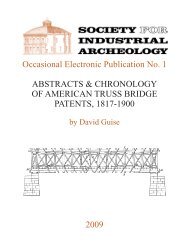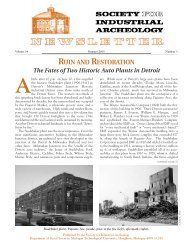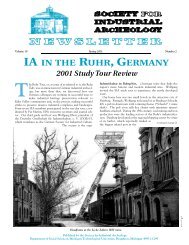birmingham, “pittsburgh of the south,” - Society for Industrial ...
birmingham, “pittsburgh of the south,” - Society for Industrial ...
birmingham, “pittsburgh of the south,” - Society for Industrial ...
You also want an ePaper? Increase the reach of your titles
YUMPU automatically turns print PDFs into web optimized ePapers that Google loves.
(continued from page 12)<br />
present it be<strong>for</strong>e <strong>the</strong> board <strong>of</strong> <strong>the</strong> SIA. That’s great news.<br />
Your contributors to <strong>the</strong> editorial page ask, what is <strong>the</strong> role <strong>of</strong><br />
SIA today? How do pr<strong>of</strong>essionals and non-pr<strong>of</strong>essionals relate to<br />
SIA? Your organization has a broad-based membership that, as a<br />
whole, has <strong>the</strong> ability to discern which sites have importance<br />
within <strong>the</strong> nation. SIA members learn from each o<strong>the</strong>r on a continuing<br />
basis as to what is archeologically significant in <strong>the</strong>ir<br />
region. Regional chapters hold seminars and organize tours to<br />
bring important attention to sites <strong>of</strong> concern. This is invaluable.<br />
The decisions every society must make over which historic<br />
properties stay or go are ultimately political. But <strong>the</strong> politicians<br />
look to <strong>the</strong> experts and <strong>the</strong> experts look to <strong>the</strong> data. The<br />
Advisory Council on Historic Preservation has only twelve<br />
administrative reviewers to analyze every site across <strong>the</strong> nation. I<br />
suggest SIA take <strong>the</strong> opportunity to seek to be a participating<br />
organization in all 106 reviews that involve industrial properties.<br />
In inner cities, factories and mill buildings are being abandoned at<br />
an unbridled rate. It will take an organization such as SIA to provide<br />
expert recommendations <strong>for</strong> preservation. The citizens <strong>of</strong><br />
<strong>the</strong> nation will benefit from this important role <strong>of</strong> <strong>the</strong> SIA.<br />
To <strong>the</strong> Editor:<br />
Barbara Small<br />
Paterson Friends <strong>of</strong> Great Falls<br />
Jersey City, NJ<br />
This is a follow-up to David Soo’s piece on Paterson. In<br />
September, I resigned <strong>the</strong> job <strong>of</strong> conducting an industrial archeology<br />
survey <strong>of</strong> <strong>the</strong> ATP site in Paterson’s National Historic Landmark<br />
District after a series <strong>of</strong> serious breaches <strong>of</strong> support trivialized my<br />
ef<strong>for</strong>ts to keep <strong>the</strong> site’s development in compliance with <strong>the</strong> preservation<br />
regulations <strong>for</strong>mulated by <strong>the</strong> U.S. and New Jersey governments.<br />
During <strong>the</strong> two years that this survey was being undertaken,<br />
I attended several meetings with <strong>the</strong> regulatory agencies in which I<br />
gave updates on our progress. At those meetings, <strong>the</strong> City <strong>of</strong> Paterson<br />
<strong>of</strong>ten had to explain why it had breached <strong>the</strong> rules. Each time <strong>the</strong><br />
agencies worked out ways to correct and proceed with <strong>the</strong> project and<br />
with Paterson’s assurance <strong>of</strong> future good behavior. Paterson did not<br />
make good on any <strong>of</strong> <strong>the</strong> promises and continued to make little or no<br />
adjustments to <strong>the</strong>ir plans <strong>for</strong> <strong>the</strong> sake <strong>of</strong> historic preservation.<br />
I’ve come to <strong>the</strong> conclusion that we will continue to see and pay<br />
<strong>for</strong> a policy that will ensure that <strong>the</strong> redevelopment <strong>of</strong> Paterson’s<br />
NHL District will be done in ways that suit development at <strong>the</strong><br />
expense <strong>of</strong> historic preservation. Paterson’s record is abysmal. For<br />
example, back in <strong>the</strong> 1970s Paterson kept preservationists, including<br />
<strong>the</strong>ir own industrial archeologists, away from <strong>the</strong> “restoration<strong>”</strong><br />
<strong>of</strong> one <strong>of</strong> <strong>the</strong> main raceways. Without a historic clue, <strong>the</strong>y<br />
removed <strong>the</strong> raceway’s clay liner with heavy machinery and caused<br />
a leak that has not been within anyone’s power to mend.<br />
More recently, a new building was constructed on <strong>the</strong> area documented<br />
as <strong>the</strong> site <strong>of</strong> Paterson’s first mills. A policy was put in<br />
place in which below-ground industrial archeology was limited<br />
only to observations made during <strong>the</strong> contractor’s excavations <strong>for</strong><br />
<strong>the</strong> new building. The report <strong>of</strong> this work tells <strong>of</strong> seeing early<br />
walls beneath <strong>the</strong> foundations <strong>of</strong> <strong>the</strong> last factories on <strong>the</strong> site. We<br />
will never know what <strong>the</strong>y were because <strong>the</strong>y could not be identified<br />
during excavation. In o<strong>the</strong>r words, <strong>the</strong> archeologists could<br />
not carry out a method <strong>of</strong> research that might have answered<br />
many questions about <strong>the</strong> first mills built on <strong>the</strong> raceways <strong>of</strong><br />
Paterson.<br />
Lastly, if we examine <strong>the</strong> loss <strong>of</strong> technical reports and artifact<br />
<strong>Society</strong> <strong>for</strong> <strong>Industrial</strong> Archeology Newsletter, Vol.28, No. 4, Winter 1999<br />
LETTER TO THE EDITOR<br />
collections, <strong>the</strong> lack <strong>of</strong> master planning, <strong>the</strong> sad Paterson<br />
Museum, and <strong>the</strong> lack <strong>of</strong> city commitment to interpretation and<br />
maintenance <strong>of</strong> <strong>the</strong> landmark district, we would discover a mess.<br />
Should this be swallowed whole? After all, <strong>the</strong>y’re too dumb to<br />
get it right in Paterson and New Jersey. I’m from Jersey and I don’t<br />
care to go that route because I see a very astute political situation<br />
in which Paterson has used <strong>the</strong> historic landmark as a way to garner<br />
preservation funds and <strong>the</strong>n use guile to keep control <strong>of</strong> those<br />
resources. Let me be <strong>the</strong> first to say publicly, “The King has no<br />
clo<strong>the</strong>s on.<strong>”</strong> I suggest that we coalesce our ef<strong>for</strong>ts around <strong>the</strong><br />
notion that an outside agency, i.e. <strong>the</strong> National Park Service, come<br />
to Paterson to develop <strong>the</strong> historic landmark and control <strong>the</strong> use<br />
<strong>of</strong> preservation funds in some way that will allow redevelopment<br />
without <strong>the</strong> loss <strong>of</strong> <strong>the</strong> very reason <strong>for</strong> <strong>the</strong> landmark’s existence.<br />
Proposed Slate<br />
2000 SIA Election<br />
Edward S. Rutsch<br />
Newton, NJ<br />
The SIA Nominations Committee is pleased to present<br />
<strong>the</strong> following slate <strong>of</strong> candidates <strong>for</strong> <strong>the</strong> 2000 elections<br />
<strong>of</strong> Directors and Officers:<br />
Vice President: Chris Andreae<br />
(2-year term): Elect one Vance Packard<br />
Treasurer: Nanci K. Batchelor<br />
(3-year term): Elect one<br />
Secretary: Richard K. Anderson, Jr.<br />
(3-year term): Elect one<br />
Director: Robert C. Stewart<br />
(3-year term): Elect two Mary Habstritt<br />
Bode Morin<br />
Nominations Committee: Lee Maddex<br />
(3-year term): Elect one Bob Frame<br />
SIA by-laws state that <strong>the</strong> Nominations Committee shall notify<br />
<strong>the</strong> membership <strong>of</strong> <strong>the</strong> proposed slate <strong>of</strong> candidates no later than<br />
70 days be<strong>for</strong>e <strong>the</strong> Annual Business Meeting (Section 2.05.a). This<br />
is that written notice, it is not a ballot. Additional nominations<br />
can be made in writing over <strong>the</strong> signatures <strong>of</strong> no fewer than twelve<br />
(12) members in good standing (dues paid <strong>for</strong> 2000) and delivered<br />
to <strong>the</strong> chair <strong>of</strong> <strong>the</strong> Nominations Committee at <strong>the</strong> address below<br />
by April 15, 2000. Candidates must have given <strong>the</strong>ir consent to be<br />
nominated and must also be members in good standing. Ballots<br />
with a biographical sketch and photograph <strong>of</strong> each candidate will<br />
be mailed to members <strong>for</strong> a vote in late April.<br />
The 2000 Nominations Committee is Robert H. Casey (chair),<br />
David Shayt, Patrick Harshbarger, Fred Quivik, ex-<strong>of</strong>ficio. Reply<br />
to: SIA Nominations Committee, c/o Robert H. Casey, Henry<br />
Ford Museum, Box 1970, Dearborn, MI 48121-1970.<br />
Reminder: SIA membership dues were mailed in late December.<br />
Only members who have paid <strong>the</strong>ir dues will be allowed to vote.<br />
The membership period is <strong>the</strong> calendar year. ■<br />
15






